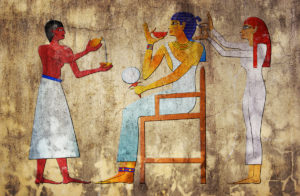It’s fairly common knowledge that Barbers were once also surgeons, and that the Barber’s red and white pole originated from a representation of the two long red and white bandages used in their bloodletting days, one twisted around the arm before bleeding, and the other used to bind it afterwards.

But did you also know that Barbers in ancient Egypt had a role as priests who attempted to fight off evil spirits?
In those days, hair was thought to be a channel by which demons could enter the body, so Barbers’ skills were seriously in demand for hair and beard trimming. Primitive man was very superstitious and the early tribes believed that both good and bad spirits inhabited every individual. The earliest records of Barbers show that as a result of these beliefs, they were some of the most important members of their community.
Barbers also at one time arranged marriages and baptised babies too, taking centre stage in religious ceremonies, where hair was allowed to hang loosely over the shoulders so that the evil spirits could come out. At the end of the celebrations, the long hair would be cut and fastened tightly to the head so that the evil spirits could not get in or the good spirits get out.
As society evolved, barbers became less revered as religious leaders in their own right, but the relationship between priesthood and barber continued during the Dark Ages, when monks and priests had the responsibility of physicians to their community, given their elevated status in terms of learning. There were no doctors or surgeons during this period, and many of the curable diseases we see today or have managed to eliminate from the population were fatal.
“Bloodletting” was seen as a cure-all and the clergy were the ones who performed this. They also enlisted barbers as their assistants and the two professions worked together until the mid-1100s, when it was declared sacrilegious for ministers of God to draw blood from the human body. The barbers took over the bloodletting duties entirely, thus the era of barber-surgeons began. It continued for centuries, until in 1800 the Royal College of Surgeons was established.